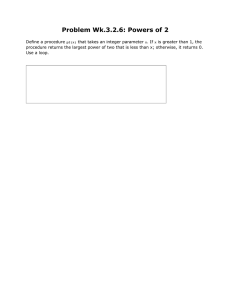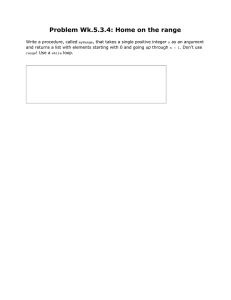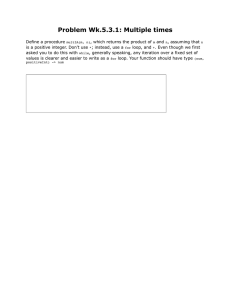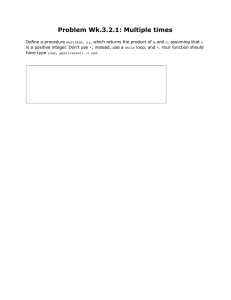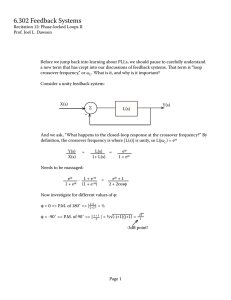6.302 Feedback Systems
advertisement
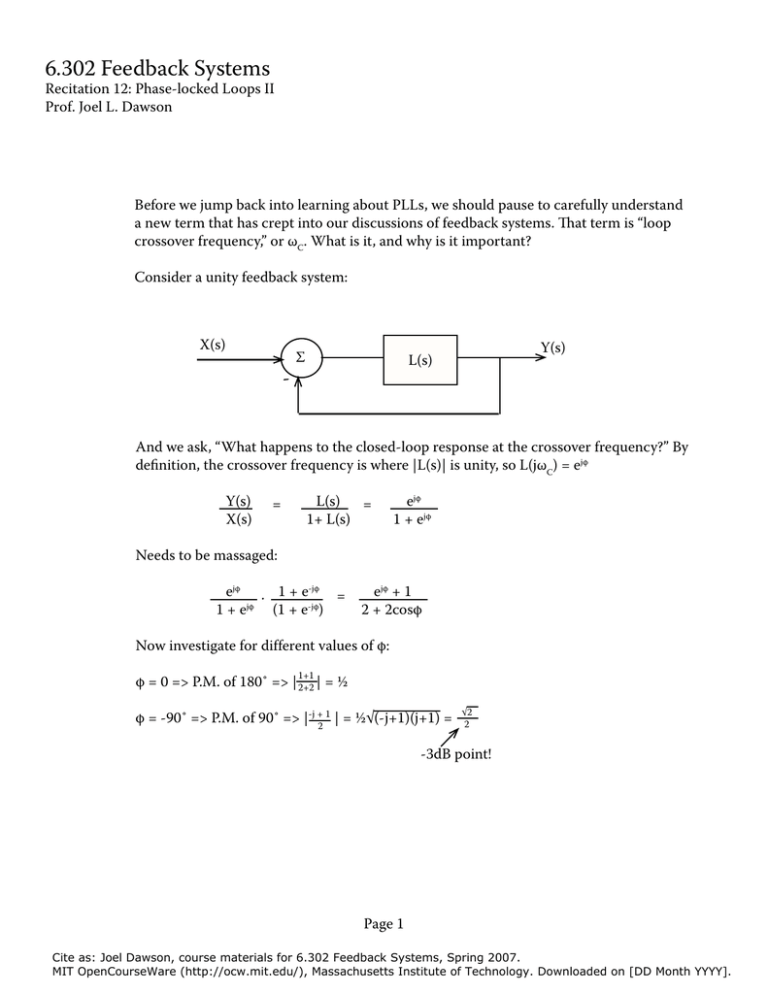
6.302 Feedback Systems
Recitation 2: Phase-locked Loops II
Prof. Joel L. Dawson
Before we jump back into learning about PLLs, we should pause to carefully understand
a new term that has crept into our discussions of feedback systems. That term is “loop
crossover frequency,” or ωC. What is it, and why is it important?
Consider a unity feedback system:
X(s)
-
Σ
Y(s)
L(s)
And we ask, “What happens to the closed-loop response at the crossover frequency?” By
definition, the crossover frequency is where |L(s)| is unity, so L(jωC) = ejφ
Y(s)
X(s)
=
L(s) =
+ L(s)
ejφ
+ ejφ
Needs to be massaged:
ejφ · + e-jφ =
+ ejφ ( + e-jφ)
ejφ + 2 + 2cosφ
Now investigate for different values of φ:
+
φ = 0 => P.M. of 80˚ => | 2+2 | = ½
φ = -90˚ => P.M. of 90˚ => |-j +2 | = ½√(-j+)(j+) =
√2
2
-3dB point!
Page Cite as: Joel Dawson, course materials for 6.302 Feedback Systems, Spring 2007.
MIT OpenCourseWare (http://ocw.mit.edu/), Massachusetts Institute of Technology. Downloaded on [DD Month YYYY].
6.302 Feedback Systems
Recitation 2: Phase-locked Loops II
Prof. Joel L. Dawson
φ = -20˚ => P.M. of 60˚ =>
φ = -35˚ => P.M. of 45˚ =>
√3
-0.5 - 2 j +
2 + 2(-.05)
=
√2
2
- √2
j +
2
= .3
2 + 2(- √2 )
2
√3
- 2 -½j +
φ = 50˚ => P.M. of 30˚ =>
= .93
2 + 2(- √3 )
2
log |
L(s)
+ L(s)
φ=-50˚
|
0
φ=0
ω
vicinity of ωC
So at loop crossover, we stop getting the desired |
L(s)
+ L(s)
|≈ behavior.
Now, let’s get back to understanding phase-locked loops. How are they actually used?
EXAMPLE : FM Radios (“FM” = frequency modulation)
Audio frequencies fall in the region from about 20Hz up to about 20kHz. If you want to transmit this information via electromagnetic waves, your first attempt might look something
like this:
)
)
)
antenna
A
microphone
Page 2
Cite as: Joel Dawson, course materials for 6.302 Feedback Systems, Spring 2007.
MIT OpenCourseWare (http://ocw.mit.edu/), Massachusetts Institute of Technology. Downloaded on [DD Month YYYY].
6.302 Feedback Systems
Recitation 2: Phase-locked Loops II
Prof. Joel L. Dawson
In order for this to work, the antenna would have to be HUGE...the wavelength through free
space for a kHz E&M wave is 300 km. So we arrange to have the audio spectrum centered
about a high-frequency carrier.
X(jω)
20kHz
ω0
2π·(88MHz-08MHz)
This frequency shift is called modulation. For an FM modulation:
)
m(t)
VCO
)
)
f(t)
ω=ω0 + k0m(t)
How do we demodulate this signal? With a PLL of course!
m(t)
phase
detector
loop
filter
VCO
cos(ω0 + k0m(t))t
cos(ω0 + k0m(t))t
For a demanding audio application like high fidelity FM, we probably want a PLL that tracks
well (has zero steady-state error) and isn’t wider bandwidth than necessary. Let’s review our
PLL performance from last recitation and see if we can improve it.
Page 3
Cite as: Joel Dawson, course materials for 6.302 Feedback Systems, Spring 2007.
MIT OpenCourseWare (http://ocw.mit.edu/), Massachusetts Institute of Technology. Downloaded on [DD Month YYYY].
6.302 Feedback Systems
Recitation 2: Phase-locked Loops II
Prof. Joel L. Dawson
First-order Loop
φIN
Σ
φe
k0
s
F(s)
kD
For the first-order loop, we chose F(s) = . What did we find? We checked the steady-state
error in response to a phase ramp φIN = ω0t (
cos ω0t):
lim
t→∞
lim
ω
φe = s→0 s · s20
(
+ L(s)
)=
ω0
s
lim
s→0
ω
= k k0
D 0
+ kDk0
s
Look at loop crossover for this PLL: |L(s)| = → ω0 = kDk0 so our steady-state error and
bandwidth are tightly coupled. Small error implies large bandwidth → high susceptibility to
noise.
How to improve? Use a ...
Second-order loop
F(s) = τs + s
L(s) = kDk0(τs+)
s2
What’s the steady-state error?
lim
ω
lim
t →α φe = s →0 s · s20
lim
= s →0 s ·
ω0
/s
+
kDk0(τs+)
s2
( s + k ks (τs+) )
/2
2
=0
D 0
Page 4
Cite as: Joel Dawson, course materials for 6.302 Feedback Systems, Spring 2007.
MIT OpenCourseWare (http://ocw.mit.edu/), Massachusetts Institute of Technology. Downloaded on [DD Month YYYY].
6.302 Feedback Systems
Recitation 2: Phase-locked Loops II
Prof. Joel L. Dawson
Steady-state error is perfect! What about the loop crossover frequency ωC?
L(s) ≈
kDk0
s2
-2
kDk0τ2
L(s) ≈
-
kDk0τ
s
/τ
-90˚
-80˚
In order to have good phase margin, we will choose crossover to occur in the region where
L(s) is approximated by L(s) ≈ k ks τ . Thus:
D 0
ωC = kDk0τ
Comparison:
first-order loop
second-order loop
steady-state error
ω0
k0kD
0
loop crossover
k0kD
k0kDτ
For second order loop, zero error plus bandwidth of our choosing.
Page 5
Cite as: Joel Dawson, course materials for 6.302 Feedback Systems, Spring 2007.
MIT OpenCourseWare (http://ocw.mit.edu/), Massachusetts Institute of Technology. Downloaded on [DD Month YYYY].
6.302 Feedback Systems
Recitation 2: Phase-locked Loops II
Prof. Joel L. Dawson
Look at Nyquist Plot for second order loop:
>
jω
-/τ
×
σ
>
>
2
Re{L(s)}
>
>
Im{L(s)}
>
>
>
jω
Root locus:
>
×
σ
>
Page 6
Cite as: Joel Dawson, course materials for 6.302 Feedback Systems, Spring 2007.
MIT OpenCourseWare (http://ocw.mit.edu/), Massachusetts Institute of Technology. Downloaded on [DD Month YYYY].
